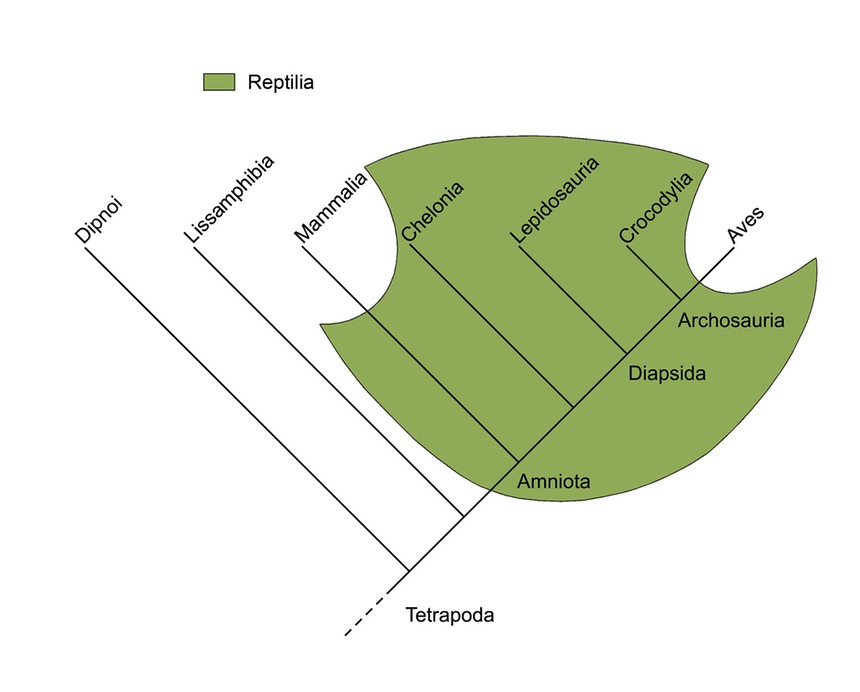TAXONOMY
Kingdom: Animalia
Phylum: Chordata
(unranked) Amniota
Class: Reptilia
Reptiles are a well known division of animal life known to ancient peoples. Due to their often distinct appearance of scaly skin and often cool touch, they are often also called cold blooded.
Indeed one of the defining characteristics of reptiles is that they are a ectotherms- meaning they generally need heat from the environment (usually the Sun) in order to move and become active.

A blue tongued lizard or skink, most likely a blotched blue-tongued lizard (Tiliqua nigrolutea). image: R.Conan-Davies
Although most reptiles lay eggs to reproduce, some research suggests that it may not have always been the case back in evolutionary time. Reptile like species may have been switching between live birth and egg laying depending on their circumstances.
Wikipedia's version
Reptiles, the class Reptilia, are an evolutionary grade of animals, comprising today's:
- turtles,
- crocodilians,
- snakes,
- lizards and tuatara,
as well as many extinct groups.
A reptile is any amniote (a tetrapod whose egg has an additional membrane, originally to allow them to lay eggs on land) that is neither a mammal nor a bird

The traditional class Reptilia (green field) includes all amniotes which are not mammals or birds, making it a paraphyletic group. image: wikipedia
Unlike mammals, birds, and certain extinct reptiles, living reptiles have scales or scutes (rather than fur or feathers) and are cold-blooded. Advocates of phylogenetic nomenclature regard the traditional category 'Reptilia' to be invalid, and prefer to use the 'Amniota' or rather 'Sauropsida' category, because not all descendants of a common ancestor are included.

Reptiles, from Nouveau Larousse Illustré, 1897-1904: Notice the inclusion of amphibians (below the crocodiles). image: wikipedia
However, in practice, these non-cladistic classifications, such as reptile, fish, and amphibian, remain in use by some biologists, especially in popular books written for a general audience. The historically combined study of reptiles and amphibians is called herpetology.
Cladogram showing relationships of extant members of the Sauria. Numbered items are: 1. Tuatara 2. Lizards 3. Snakes 4. Crocodiles 5. Birds. "Lizards" are paraphyletic. Branch lengths do not indicate divergence times. image: wikipedia
The evolution of the first reptiles
The earliest known reptiles originated around 315 million years ago during the Carboniferous period, having evolved from advanced reptile-like amphibians that became increasingly adapted to life on dry land.

The first reptiles had an anapsid type of skull roof, as seen in the Permian genus Captorhinus. image: wikipedia
Some early examples include the lizard-like Hylonomus, Casineria and possibly Westlothiana, although the latter may be an advanced land-dwelling amphibian.
In addition to the living reptiles, there are many diverse groups that are now extinct, in some cases due to mass extinction events. In particular, the K–Pg (Cretaceous–Paleogene boundary) extinction wiped out the pterosaurs, plesiosaurs, ornithischians, and sauropods, as well as many species of theropods (e.g. tyrannosaurs and dromaeosaurids), crocodyliforms, and squamates (e.g. mosasaurids).
Distribution
Modern reptiles inhabit every continent with the exception of Antarctica. Several living subgroups are recognized:
- Testudines (turtles, terrapins and tortoises): approximately 400 species
- Sphenodontia (tuatara from New Zealand): 2 species
- Squamata (lizards, snakes, and worm lizards): over 9,600 species
- Crocodilia (crocodiles, gavials/gharials, caimans, and alligators): 25 species
What about the difference with birds?
Although they have scutes on their feet and lay eggs, birds have historically been excluded from the reptiles. They, therefore, do not appear on the list above. However, as some reptiles are more closely related to birds than they are to other reptiles — crocodiles are more closely related to birds than they are to lizards — cladistic writers who prefer a more unified grouping usually also include the birds, which include over 10,000 species.
Overall description and reproduction
Reptiles are tetrapod vertebrates, either having four limbs or, like snakes, being descended from four-limbed ancestors. Unlike amphibians, reptiles do not have an aquatic larval stage.
Most reptiles are oviparous (egg-laying), although several species of squamates are viviparous, as were some extinct aquatic clades— the fetus develops within the mother, contained in a placenta rather than an eggshell.
Crocodilian Egg Diagram 1. eggshell, 2. yolk sac, 3. yolk (nutrients), 4. vessels, 5. amnion, 6. chorion, 7. air space, 8. allantois, 9. albumin (egg white), 10. amniotic sac, 11. crocodile embryo, 12. amniotic fluid. image: wikipedia
As amniotes, reptile eggs are surrounded by membranes for protection and transport, which adapt them to reproduction on dry land. Many of the viviparous (young internally developing) species feed their fetuses through various forms of placenta analogous to those of mammals, with some providing initial care for their hatchlings.
Typical sizes of reptiles
Extant reptiles range in size from a tiny gecko, Sphaerodactylus ariasae, which can grow up to 17 mm (0.7 in) to the saltwater crocodile, Crocodylus porosus, which may reach 6 m (19.7 ft) in length and weigh over 1,000 kg (2,200 lb).
Size comparison of the Nile crocodile Crocodylus niloticus (average and largest recorded specimens) with a human. image: wikipedia
Source: http://en.wikipedia.org/w/index.php?title=Reptile&oldid=610830687
Celebrations: 21 October is Reptile Awareness Day
From around the web…